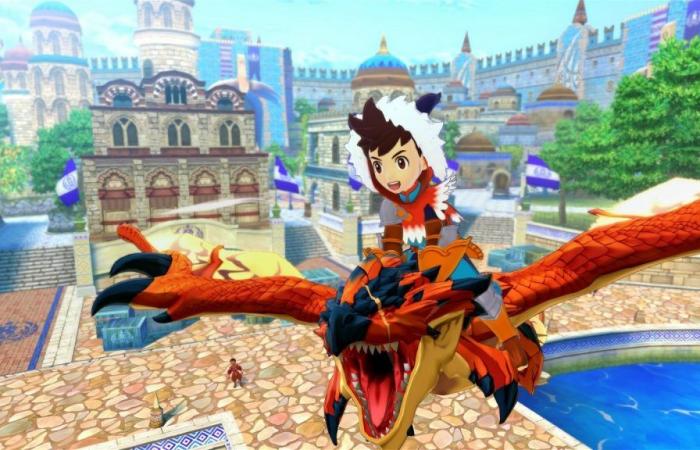How much has changed since its debut on the market? Which audience are these two titles aimed at? How much do you need to have played the main saga to appreciate these spin-offs?
For the answers to these (and other) questions, all you have to do is continue reading.
Monster Hunter Stories
Launched exclusively on Nintendo 3DS in 2017, and landed on the mobile market less than a year later, with a conversion that raised the resolution but left all other aspects unchanged, Monster Hunter Stories represents the definitive customs clearance of the Monster Hunter franchisewhich in recent years has gone from a niche brand for fans of games made in Japan to global phenomenoncapable of selling millions of copies on all platforms even in the West.
So many as to push Capcom to experiment, moreover with a genre that has not always met the tastes of today’s general public such as that of turn-based role-playing games.
But when the “factor Pokémon“, nothing is taken for granted: Monster Hunter Stories it wasn’t simply a turn-based JRPG, but it was based on “collectible” mechanics that made GameFreak’s little monsters immortaltaking advantage of the generous size of the parent franchise’s bestiary.
Monster Hunter Stories also opens up to those who are certainly not looking for a prohibitive challenge, offering an adventure full of exploration, funny situations and monster-based fights.
Framed in a light and rather carefree narrative framework, which reflects the audience to which the product is aimed, the game structure follows the one that millions of Pikachu fans and company have learned to love over the years, from research to capturing specimens to then be deployed in battle, passing through the shaping of their growth path.
With a fully customizable party and probably constantly changing, the player is called to an adventurous journey, full of combat, funny situations and explorationin which the stereotypes of the genre meet a new audience, perhaps alienating the historical fans of the franchise, thanks to a lower difficulty level, but attracting crowds of new ones, especially among the younger ones.
But Capcom has not limited itself to slavish imitation here: the Monstie can be ridden and their skills exploited in various areas of the scenario, to open new roads, reach otherwise inaccessible secrets and perhaps avoid dangerous areas, such as pools of lava or poisonous terrain.
The combat system rests on a Paper, Scissors, Rock style triangle, which sees Power, Speed and Technique fighting each otherincreasing the strategic rate of clashes and rewarding players capable of fielding a team that is not only capable but also as versatile as possible.
And again: the game procedurally generates the positioning of the monsters’ lairs, which contain the eggs inside them, so precious for replenishing our army of Monstie, and is careful not to punish experiments and approximate builds: running into the game screen over is difficult if you’ve played at least a couple of RPGs before this one, and no player is potentially left out of the fun.
The source of inspiration is evident, in short, and yet the result does not result in a simple imitation: today like seven years ago, Monster Hunter Stories it is an ideal JRPG not only for those who are unfamiliar with the franchise, but also for those who intend to tiptoe into the fantastic world of Japanese turn-based role-playing games.
Monster Hunter Stories 2
Monster Hunter Stories 2 was launched in 2021, four years after its predecessor, still exclusively for Nintendo machines, and represented the most natural evolution for the franchisetaking up and refining most of the mechanics seen in the first chapter and taking advantage of the greater freedom granted to the development team by the increased power of the host console, with the transition from 3DS to Switch.
The novelty compared to the predecessor there aren’t that many, but they all go into the direction to expand and improve the basic formulasuch as the possibility of being helped by a second human Rider (and his Monstie) in certain fights, or the increased influence that the player can exercise on the eggs and composition of his party, not to mention the increase in Monstie deployable in battle, which goes from the seventy seen in Monster Hunter Stories to over one hundred in this sequel.
As in the first episode, the player switches from the role of hunter to that of breederwith everything that follows in terms of research and growth of one’s army, management of captured monsters and mixing of races, in order to obtain increasingly better performing specimens on the battlefield.
The crafting element also returns in an enhanced versionwhich simplifies what was seen in the original series but still allows you to get the best out of the fights, reusing the materials obtained from the monsters to compose weapons, armor and other types of equipment useful to face the threats that the substantial campaign will force us to face.
If you feel the need for further information on the game mechanics of this sequel, we refer you to our review from three years ago, which still remains completely valid as nothing has been changed in terms of game mechanics.
Miscellaneous
As we had already had the opportunity to underline in our preview, the changes made to the two games are not shockingyet they do their part in bringing these titles, especially the first one, closer to the standards set by their more recent congeners in terms of audiovisual presentation – which however are only partially maintained, as we will see.
If the first title, thanks to the space and memory limitations linked to Nintendo 3DS cartridge support, did not feature dubbing, the new version allows you to choose between the English and Japanese tracksadds a gallery containing artwork, preparatory sketches and a jukebox with all the tracks from the game and, last but not least, all DLC arrived post-launch among additional missions, new monsters and cosmetic elements.
The element that catches the eye most is obviously represented by theincreasing the resolution and by the greater sharpness of the elements on the screen. Yet, especially when playing on a large TV, the The title’s humble portable origins are evident and they place it a step below its more recent congeners, despite a good artistic direction.
Note of merit also for the readjustment of the menus and interface to the single-screen mode typical of use on Sony consoles and PCs: the menus are intuitive and fast, and their navigation never took longer than necessary during our hours of tests.
The interventions on seem even less impactful Monster Hunter Stories 2which having debuted in 2021 on Switch appears here enhanced and embellished, but much closer to its previous version than the first chapter.
The biggest differenceand it is not to be underestimated, resides in the fram erate, doubled and decidedly more stable than the numerous uncertainties seen on the Nintendo hybrid platform at launch.
PlayStation and PC players will give this box set a different value than it does for Switch users.
The games are purchasable even separatelybut given the continuity of mechanics between the two and the lowered price in the case of a bundle purchase, we advise those who do not already own a physical or digital copy of one of the two titles (and believe that they may be right for them) to possibly evaluate multiple purchases.
There console on which the titles will be used, then, inevitably goes to impact perceived value of the package and on the indispensability of the titles: if on Nintendo Switch it is possible to find the second chapter on offer, spending less but giving up the improvements to the frame rate and performance brought as a gift by the PlayStation and PC versions, it is also true that the competition saga Pokémon is strong, perhaps enough to make these titles a second choice.
On the other hand, for the players PS4 (PS5) e PC who had a weakness for games in which monsters are collected, the alternatives (especially the quality ones) are noticeably thinner, and the package – embellished with technical improvements more evident here than on Switch – it certainly takes on valueespecially for younger players.






